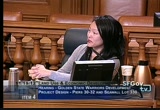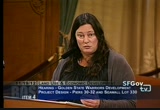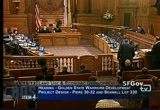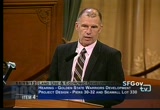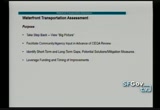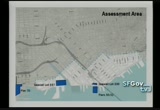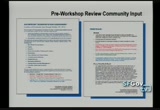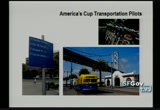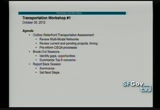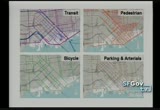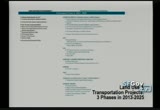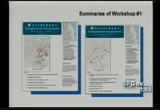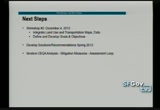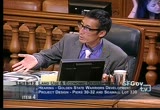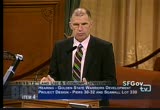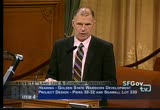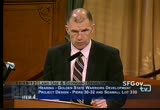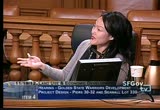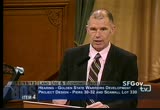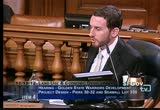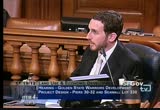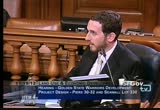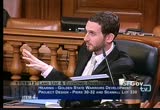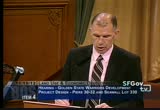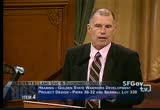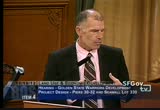tv [untitled] November 20, 2012 8:30am-9:00am PST
8:30 am
an arena and stadium in the neighborhood. thank you, ms. pagan, for being here. >> lisa pagan, office of economic and work force development. thank you, supervisors, chair mar. i led a workshop on november 5th with at least 60 attendees where we talked about safety, noise, and other sort of quality of life impacts that people were concerned about related to the proposed development at piers 30-32, but also what the concerns are today, the existing conditions and also their concerns about future impacts of the proposed development. -- for the facility and multi-entertainment sports facility. so, it was a really great workshop in the sense that i got a lot of information. we split into five break out groups. we had surveys, written surveys. they talked with the facilitator in the break out group. they put stickers where they think that the impacts would
8:31 am
happen. but they also provided a lot of verbal and we had a lot of notes, feedback. right now we're going through all of that information and we're analyzing what are the main concerns, and what do people want to preserve about what they like about the neighborhood as it exists today. so, our hope is to finish analyzing the information and then we go back to the community and have some proposals how to address what they would like to see addressed. we stuck to cleanliness, safety, noise, because the transportation issues, peter all bert had a big workshop on the week before. so we didn't focus as much on public transportation and traffic, although we did touch on where traffic control might be located and needed. so, we're in the process. we haven't come up with the answers yet, but we are going to and work with the community
8:32 am
on some strategies to address the concerns that you're talking about, cleanliness and safety and impacts of different large events happening in the neighborhood. so, if you have any other questions, i'd be happy to answer, but [speaker not understood] finish analyzing the information about the [speaker not understood]. >> thank you. >> good afternoon, supervisors. peter all bert from mta. i'm going to talk about what we're doing with the waterfront transportation assessment. i'd like to actually -- first of all, i think it's really important for us in planning transportation to take that step back and do much more than just plan for one particular project. when so much is going on in the surrounding neighborhood, this idea of doing a transportation assessment was to get out ahead of what we know are three large projects that will be coming along pretty soon.
8:33 am
we're working obviously with piers 30-32. we're aware of what is happening with mission rock. we'll be working with pier 70. it made sense for us at mta to make sure that as a stakeholder ourselves in ensuring good transportation and looking at pedestrian and bicycle and transit and traffic and parking that we also are as concerned about the quality that comes out of this. what we see is an opportunity here and i appreciate the chance to work and get ahead of this opportunity. so, the slides that i have on the powerpoint, i don't know if that's coming across -- thank you -- one of the first steps we want to do is step back and look at not just pier 30-32, but look at the bigger waterfront area. that was brought at the fisherman's wharf pier 70. to make sure that as we rollup our sleeves and get in the transportation problem solving that we're working with the community most affected who live day to day with some of the issues, but the idea of community is pretty big. operating transit, it's residents who live near the
8:34 am
traffic and transit issue. it's our partner agencies who deal with transportation if the employers and employee -- need to get back and forth to work. it's obviously the clients that are hoping that their proposal are better and the quality of life in san francisco fits all of that. so, we also know that getting out ahead of the problem means getting out ahead of environmental review. it would be a real disadvantage for us at mta. if we were trying to come up with solutions to transportation problems while an e-i-r is thumping along at a quick pace, doing the assessment before the e-i-r has start today begin, there is a huge opportunity and i hope it becomes a role model for how we do big projects in the future. one of the things i'm open to do with this assessment is identify schorr term and long term gaps. there is a lot already going on. but is it going on in concert with the development proposals? * the transportation assessments in the books lining up in time for the transportation challenges we've got?
8:35 am
and finally, are we being smart as a city in leveraging what's happening so that we can get much more than what we could have if we just treated it project by project by project? but instead put them together in one big network and say, working together we can do so much more than the individual projects could themselves. so, the image you have on the screen now would handicap what we're going to talk about doing. the white area, the gray area was our initial attempt to find broader than just pier 30-32. what became clear to us is those facilities outside the boundary that we're now folding into the study, the parking facilities, the ramps to the freeway, pier 70 and all that is going on around there, we're rolling out our study area to include what is happening around pier 70, the seawall lot 337 mission project near the giants ballpark. and seawall lot 330 and piers 30-32, we're also looking at also the land use changes and the transportation investments
8:36 am
in the broader area. we're also not starting from scratch. i worked very closely with america's cup. the people's plan was a product of a lot of community input and a lot of those concerns and issues came right out of the same area of the waterfront we're talking about now. because that was so recently gathered, that input, that became a great foundation for us to say, hey, if you've already spent some of those 260 meetings we had in the last two years in the america's cup, your thoughts, your comments weren't wasted on us. we recorded them, actually color-coded them to make sure i took track of what we heard in the beginning of 2010, what we heard in 2011, what we heard in 2012. these are actually online. hosted by wed's website. there are pages and pages of community input about transit, about pedestrian safety, about accessibility, about employers worried about their employees getting to work. and we also wanted to make sure that we had comments resolved in time because we had a great
8:37 am
experience with the america's cup. and ware going to have more experiences with the america's cup. last year was the first test of what is going to be more sustained series of events next summer. but it was an opportunity for us to pilot things that we heard from the community that we as agencies ourselves wanted to do. the idea of bike sharing. we know bike sharing will come out in spring. but park wide, the rental company to get our hands on spictiontion sharing experience, put it out there at the marina green and see how we could get people comfortable with this option. we tested the e line, historic streetcar and the waterfront from mission bay to fisherman's wharf. it is a streetcar with challenges to operate but we know what the challenges are and meeting with the engineers with the nta to figure out how we can sustain the e line not just for special event but for round the clock service. we also paid attention to details like pedestrian safety, way finding, helping visitors find their way around the waterfront. a quick fix, stapling a few signs to a post, but what was
8:38 am
so important about that, we used real time information that gave people choices that if they were to walk from the ferry building to the ballpark or from the ferry building to marina green, we could get them time options and show them where milestones were along the way. we also did the same with the bicycle network as our bike network expands. and with that we knew we were starting from -- with the community, a lot of the people already worked with us to roll our sleeves up and say let's get beyond america's cup event planning and talk about long-term fixes. what do we know that needs to happen in all the different modal networks, what are the timing of major projects coming and are they linked well to the transportation investments that are in the books? and are they -- are we able to get ahead of the ceqa process so we could identify solutions that make a lot of sense even while ceqa is starting to trend in its analysis? by laying out those parameters we sat down into break out sessions. we had six of them. we went through a lot of exercises using the strength of
8:39 am
people in the neighborhood knew of the issues. they marked out maps, told us their top six concerns. six groups, six concerns. we had a few that overlapped. we had a range of fib use, pedestrian, transit, parking, traffic, for people who don't care about ball games but just want to get in and out of their garages. report back structure, we summarized the feedback and now what we're doing is pointing to a lot of work ahead of us. let me sort of show you an overview of some of the basics. these maps were really helpful. it is the first time i think we layered so much richness on one simple map. for instance, the transit map shows existing and proposed transit investments. existing [speaker not understood], central subway, the caltrain extension into downtown, the local and regional networks. it's hard to real read it to scale, but people were willing to mark them up. the pedestrian network used the grid, but it also used the abag bay trail.
8:40 am
it also used corridors that were working specifically on second interest and market street, knowing there are concerns with investment * . working with cac, jamie whit can hererctiontion, gave me a richness with pedestrian safety has only helped us. bicycle network, again, existing what's proposed. parking and arterials network, facilities we know about how big the parking garages and lots were, we're expanding this network to include private garages as well as public garages because we think that the solutions lie in partnerships with private and public parking well beyond the sort of clumsy way we roll out parking resources now. so, here's a map that's otherwise impossible that really understand. now that you've seen how we built this, all these layers upon layers, what we're getting is this is a really dense rich area that has a lot of opportunity, but a lot of challenges. these circles that are radiating around pier 30-32, they could be drawn on any of the big projects. but they helped me identify how many bus stops, how many transit stops, the walking
8:41 am
distance, the parking facilities. this is the network of maps that are going to start shaping some of our solutions. so, how do we get the solutions? we pay attention to the inventory of projects that are happening not just in the next five years, or the next 15 years, but all the way out to the next 30 years. they might be hard to read so let me explain what you're looking at. this is a snapshot of what we call the second phase of three phases. between 2013 and 2017, perhaps between 2017 and 2025, will be this phase. this is the phase that has the mission rock project. the beginning of pier 70, it has the arena built out. it also has central subway. it has the caltrain electric strife indication, the implementation of phases of tep and the bike plan. * but what i'm paying attention to or we all are hopefully is are we linking these investments so they fall in time for the land use and big developments. and if not, what are the bridge measures that we need to put together so that for a year or two 2013 the opening of a big
8:42 am
opening of residential development and the central subway, * we have transit capacity in place to carry people for that year. i can tell you that working with americas cup taught me volumes about how red and i quick we can be when we're smart in planning ahead to supply the capacity when and where it needs to be. so, summaries about first round of workshops we had on october 30th, these are just two of the six slides. we have the marked up maps, the top six concerns. we also have pages of individual concerns that came out of that. these are also posted on our website because we want this process to be transparent. if you weren't able to make work shock 1 on october 30th we're hoping you'll help us december 4th the next workshop. at that workshop i've already heard loud and clear from the community let's have better data on the integration of land use and transportation. so, we are preparing maps that show not only all those transit networks but what the land use is, making sure the future transit is falling where the
8:43 am
land use needed to be. but thanks to the planning department, we've got those maps underway. what's really interesting is the comment that came out was, okay, we've got this data, we know it's happening. what's the soul of this planning? where are we going in terms of goals and objectives and what quality of the neighborhood do we really want to build? we have a lot of goals and objectives in a variety of documents already, the general plan, the transportation element of the general plan, the waterfront land use plan of the port, the area plans of south beach, rincon point, those are community objectives already set. we're going to start with those. we put them all over the walls and asked the people at the workshop these are what's in the books. help us figure out this is adequately addressing what you see emerging in this part of town because we can circle those goals and objectives and say, yes, they point to this part of the waterfront. i expect we'll need to come up as a community with new goals and objectives that reflect what is really happening. however, that should be a fantastic exercise because when we do, when we have goals and objectives, we have an inventory of all the projects in the works and when they're
8:44 am
happening and we have a list of what the concerns are, what we can start doing is fashioning some recommendations and solutions. and to do that before may 2015, get that out ahead of the published draft e-i-r for pier 30-32, it gottion us ahead of the draft e-i-r for mission rock and pier 70. so we can start pointing to tremendously valuable mitigations measures and solutions that hopefully are part of the project or certainly addressing what the project impacts are. again, i'm one of the stakeholders. my system mta needs to work well. getting ahead of the data, timing, community concerns, i will be much more confident going into an e-i-r and all of the analysis we get, understanding that i've got these ideas and this community perceptions with me. so, with that i'd be happy to take questions or move to the next presenter. >> wanted to ask mr. albert,
8:45 am
how many people participated in that october 30th workshop, and how are you doing outreach to make sure the neighbors and neighborhoods around the development are really involved? and i know lisa pagan also mentioned the neighborhoods are really critical but i just wanted to have some sense of numbers and how you're going to get better data and include the neighborhoods more. >> thank you. we had 55 people at the first workshop. working closely with [speaker not understood] helping us with outreach, she maintains the list of community members who are involved who asked questions. we also worked with the cac and the cac drives a big turnout. i'm building that mailing list as i go because as we get a lot of comments online, we have an interactive place where people can plug into give us input and be part of our e-mail list. we're trying to go beyond e-mail. we have social networks,
8:46 am
conventional mail, handwritten a few letters who to people who don't want to work on computers. this is helping get out to the bigger community. this is the time to work with us and it would be fantastic to have the input televised and having more forums like these. >> i would agree with you that the people plan for the america's cup is good data, but this is specific to this area. that's a little bit different than the america's cup which as a huge spill. i'm glad there is a commitment to work closely with the neighborhood surrounding the development. so, thank you. >> may i? >> supervisor kim. >> thank you. mr. albert, thank you so much. i do appreciate the fact i do think the outreach has been done since august in the neighborhood and there have been a number of meetings, the turnouts have been really great. i think those from the warriors and [speaker not understood] have been really supportive outreach and i want to appreciate that. for a project of this size. i was wondering if you could go
8:47 am
over a little bit some of the lessons we learned from the giants stadium as another large kind of public event institution in the city. i know that we've collected the data. we have some kind of [speaker not understood]. what were positive things the city could do or meet the needs or increase of the giants stadium? what were some of the lessons we learned, things we can improve on for the next project? >> thank you. well, looking even back as 1999 when we started projecting what we thought might happen, that was before the stadium opened, i think there were -- i have data here from my colleague jerry robbins who has been instrumental in helping build the plan. it is a little more than 52%. were expected to come by car during the weekday. that went up to 68%, 65% on the weekend. those are the assumptions in the e-i-r. they're pretty close to what happened initially. what we also saw, though, that we didn't -- that we see now
8:48 am
that are bigger numbers than we projected, a big increase in the walk and the bike mode split. the bike valley parking the giants worked really well. transit rider ship in the beginning was 41% which is easily the highest transit mode we saw in ballparks around the country. that settled into 25% mode split. it puts us in the top 3. chicago has 23-1/2. so, those benchmarks are far and above the transit mode system we've seen are around the country. i'm a little worried why we at mta contributed from the 40 to 20 and i can tell you one of the challenges we have to do is to sustain the great word of mouth. the transit is a way to get there. the list for me is the america's cup experience. you remember the weekend supposed to end by weekend. october 6 or october 7 where we had america's cup fleet week, giants, 49ers, everything happening. we had extraordinary transit modes. we had record rider ship on
8:49 am
every single conveyor of people moving out of the area. the lesson is don't scare people away. invite them to take transit. make the options real. do fantastic marketing. i have a feeling our transit was some of the highest we ever saw. it is much more malleable formula. i would say the assumptions back in '99 weren't that far off from where we were, but the trends we're seeing now are positive in getting more people walking and bicycle and especially with the america's cup experience on transit. >> my question, then -- another question on the giants stadium, when you looked at the cost in terms of the transit investments that we had to make, some increased demand in the neighborhood, do you feel like we were able to adequately calculate those costs and how with the warriors arena do we plan to estimate from that? and if the impact fee is in the rider ship, what you pay when you get on mound and i cover that, what are some ideas that we may have to explore? >> we do have a lot of great information from the america's cup.
8:50 am
i can tell you not just muni, because there is so much more [speaker not understood]. they provided what their cost was to the augmented service. america's cup, one thing we wanted to do was deal with the perception if there was a major event on one part of town draining other parts of town from resources. we developed the people plan to float the high level of transit above the baseline so you could see the ongoing service in every neighborhood isn't really affected by the great demand in the northeast waterfront. that would be the basis for this assessment. we don't want to cannibalize transit to feed another. that comes with a cost. we can provide the cost. i had a chance to meet with the ceo of the warriors, [speaker not understood]. and he's approached our cfo with some innovative ideas with his experience in phoenix and we want to make sure transbay in san francisco, phoenix and san francisco are two different city, but the idea for innovation and building in the ticket, with a ticket transit incentive is tremendous.
8:51 am
and it actually makes people feel the transit is part of the whole experience of going to the game. it actually minimizes the cost of the psychological barrier. and after the america's cup experience, we have a lot of fertile ground to work with. >> and just one more question. i know some people, and including in the plans, brought up the concept of water taxis and ferries. that can be an advantage of the site. and given, of course, we anticipate a lot of fans, others, participants from the east bay, that could be one way to kind of increase public transit, but also mitigate some of the concerns about crowd control after games as they're heading back the other way directly off the pier onto ferry boats. what is the realistic nature of those types of alternatives and how can we begin to explore them? >> thank you. so, for the transit, classic transit service, golden gate, the boat pro supplieders that take you to the ball parks, they carry about a third of the
8:52 am
transit rider ship already at the ballpark. that is a tare men disamount of lift. it is much higher than the representation of the commuters downtown. water taxi is a new animal. the port just finished the fee process. i was on the water taxi with the bidders because i wanted to see what value they could add specifically for america's cup. my brain doesn't stop therethv i wanted to look atwater taxi as a resource. [speaker not understood]. i want to talk to them more extensively about next year. this gives us plenty time what water taxis mean by the time it is open in 2017, 2018. >> thank you. i just want to say i think this is a truly critical part of this development as we move forward and i appreciate the work that is happening in this area. i know that supervisor wiener has some questions, but i just want to make sure that we continue to look at this, one of the top concerns of course are we going to be able to [speaker not understood] to meet this need and how do we serve it, but also not impact other parts of the city as
8:53 am
well. and then how can we also enhance some of the existing issues that already exist in the neighborhood even without the warriors arena that have safety issues, the bike access as well as other public transit. you i really look forward to working with you and the mta as we move forward with this. i believe supervisor wiener has questions as well. * >> thank you, mr. chairman. thank you for that presentation, mr. albert. very much appreciate it. the plan seems like solid in many ways but in the linchpin to all of this is muni. i'm hopeful to have a great water taxi system even better, better and berry ferry system. hopefully the cpuc won't kill off the uber and other kinds of innovative car sharing services and we'll be able to have that and better biking and pedestrian. really at the heart of this is muni. and i guess my question for you
8:54 am
is putting aside sort of the grand planning and vision, what level of confidence do you have by the time this arena opens, muni is actually going to do what it needs to do to invest in a system and expand the system and be able to actually service this? because this is a lot of [speaker not understood]. i'm very supportive of this project. i think it could be a really, really great thing for san francisco. but i do have concerns about whether muni will actually be able to in a very tangible way invest in the system, make it more reliable and expand the system to allow this to work. i mean, we've seen, for example, in terms of muni's toke of light rail vehicles, a whole hearing on this this morning, it has typically -- you need 114 to operate and typically has 114 functional. so, if one goes out of service, there is usually nothing to replace it.
8:55 am
we've seen in my district the upper market area where we're adding thousands of units of new housing and our subway capacity is inadequate to meet current demand. and i keep promising my constituents that, don't worry, muni is on it. we're going to be working very hard and expanding service and making it more reliable. but at some point it starts to ring hollow. so, i want this to succeed and i don't want it to be a transportation nightmare. and i think for that to happen, muni has to be able to invest and expand. and right now i don't see that. and i think very highly of current muni management. but i think we just don't see the level of investment that we need for a growing system. so, i'd be curious to know your thoughts on that. >> thank you. as a constituent of the district when somebody gets passed by trains are too crowded by the time you get to church street, i would be the first person [speaker not understood] when it comes to working with my management if there wasn't a level of commitment. here's what i can tell you.
8:56 am
at america's cup we learned what we can do. we have a team, a system that is going to be incidental or instrumental to managing loads that are above and beyond extraordinary. i think that is one of the big concerns if we have an arena and ballpark and new development at pier 70, clearly there are going to be demands on the system that are bigger. >> if i can interject and i'm sorry to interrupt. i think mta did an outstanding job around the america's cup and whatever -- the 12 things were happening in the city the same day. absolutely outstanding job. that is a very unique and singular situation. america's cup is not a great comparison because it's specific dates. it's not many days a year every year into eternity. and, so, i think this is much more about the structural day-to-day operations of muni. >> thank you. that's where i was going. so, when we did this episodic
8:57 am
heavy lift, we learned there are going to be things hard to sustain. why do we not do this kind of service all the time? what are the capital shortcomings of the system that make it hard for us to run the e line and augment the others? what are the operational challenges? because to get a bunch of operators in for a big day is one thing. how do you sustain that, how do you train the drivers in advance? how do you have a graduating class well before the demand? this year a few things given me a greater sense of confidence. we worked on this and did some of the planning at the hunters point shipyard. to procure the streetcars we need, we need them three years in advance of when they should be running. we have to order streetcars so we have bigger capacity, we have to be three years ahead of the implementation of the project. so, we've embedded now in the procurement cycle the extra streetcars we need working with the capital program. he knows what the model will tell us. he'll put it into the capital program and then we'll have a fleet, not the order when they're needed to run, but the order tested, the streetcars and actually running on the
8:58 am
street. the cost of the infrastructure itself, the rail, the rail switches that help the e he line work not just when there is a big day but around the clock, those are real switches that make it easier for drivers to not have to get out of the trains and flip the switch and get back in the train. those are embedded not necessarily extensive, but they need to be part of the capital program. there is a whole spreadsheet of all the operational capital investments that are needed to get this level of service not just for an episodic thing, but for really the quality of the whole waterfront. that is part of our assessment. and a lot of that [speaker not understood] america's cup because we pushed up against the capacity of the system. that tells you we're paying attention to what the shortfall is between an episodic thing and permanent. >> absolutely. in terms of the planning and the thinking, what you're doing, i think it's all very best of the best.
8:59 am
[speaker not understood] -- i'm not convinced -- i want to be convinced muni will do what it needs to do and stay focused for a sustained period of time on improving and expanding service. >> just to conclude that, i had meetings with john haley next week. he's going to help me with the service planning. he's going to know the full range of it. the trick of this assessment is that not all the impacts are going to happen in the next year or next few years. so, we do have to measure up with the milestones when a certain development opens. [speaker not understood] we're not just paying attention to the waterfront projects. we're looking at the transbay transit center. we're looking at all other a big demands. it would be wrong for us to be claiming for capacity improvements just on the waterfront when so much is happening one block inland. do share your confidence with the administration. i've worked with muni long enough to see the different responses that come out of these demands, the teams, input in command that report back to capital and say if you want to
115 Views
IN COLLECTIONS
SFGTV: San Francisco Government Television Television Archive
Television Archive  Television Archive News Search Service
Television Archive News Search Service 
Uploaded by TV Archive on

 Live Music Archive
Live Music Archive Librivox Free Audio
Librivox Free Audio Metropolitan Museum
Metropolitan Museum Cleveland Museum of Art
Cleveland Museum of Art Internet Arcade
Internet Arcade Console Living Room
Console Living Room Books to Borrow
Books to Borrow Open Library
Open Library TV News
TV News Understanding 9/11
Understanding 9/11